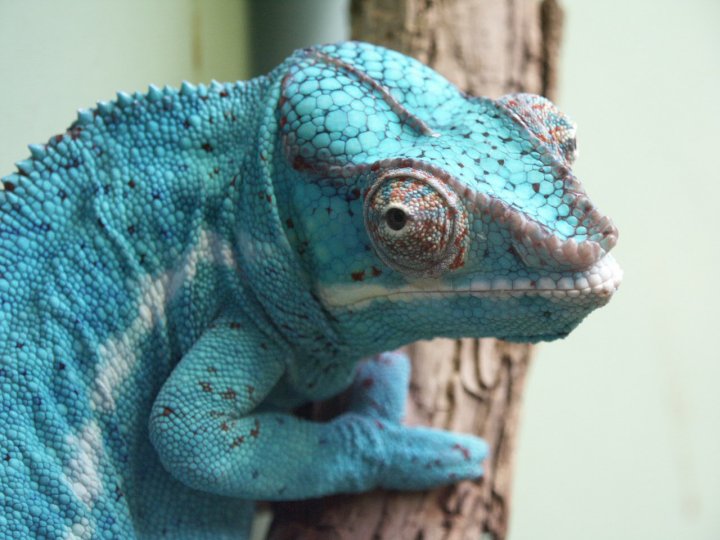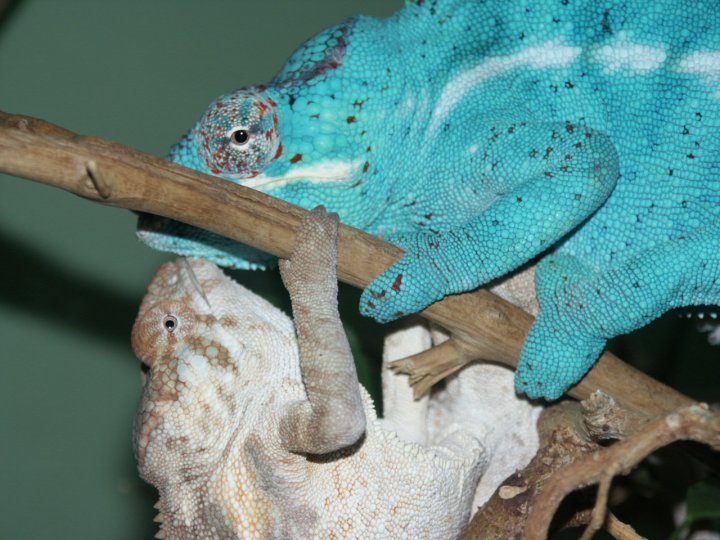


The male Panther Chameleon. |
ScientificName:Chamaeleo [furcifer] pardalis |
| Geographical Range: The Panther Chameleon lives in the northern and coastal areas of Madagascar. | |
| Habitat: The Chameleon lives in the forest areas and sometimes in the rain forest. It lives mostly in the coastal lowlands where it is warm and humid. The temperature range is from 72-83 degrees Farenhieght and the humidity range is from 70-100%. They like to be off the ground, up in the trees and bushes. | |
| Diet in the Wild: insects, small birds, and other reptiles
Diet in the Zoo: crickets and beetle larva dusted with calcium- In captivity the adults may eat every other day. The babies will eat daily. Their diet can also consist of moths and grasshoppers for adults, and wax worms, meal worm, and fruit flies for the babies. |
|
| Conservation Status:Not protected. | |
| Location in the Zoo:Herpetarium | |
| |
|
| Physical
Description:
The chameleon's body is flattened from side to side. Their legs project to the side and to the back of them. Their legs are also specially jointed so that all four feet can easily grasp a branch located below their body. The chameleon's head has a hard shaped helmet that helps protect it. Their eyes extend out of their head and are covered with scaly skin. Both eyes can turn on their own to look in different directions at the same time. Vision is more important to the chameleon than their sense of smell. They're main defense mechanisms is visual cues. The chameleons tails are prehensile, which means that they can use their tails to grab things. The tails are sometimes curled. Also, the tail provides additional support for catching prey. The feet of the chameleon are V-shaped and perfect for grabbing
branches. On the front two feet each one has two toes on the outside
and three toes on the inside. On the hind feet there are three
toes on the outside and two toes on the inside. By the toes being
specailly positioned, they assist greatly in balancing.
|
Social
Organization:
Sexes are
separated both physically and visually, except for mating. To
see another Chameleon stresses them out too badly. General Information: The chameleons live two to three years in the wild. In captivity they can live five to seven years depending on how well they are taken care of. Chameleons, in captivity, most likely will not drink out of a bowl of water. The chameleon needs to see moving water to actually drink it. Therefore, it can easily dehydrate which would result in kidney failure and in the end he would die. The chameleon prefers to lick the dew off of the leaves in the early morning or catch drops of rain dripping down their faces. But he can drown easily because he breathes through a hole in the bottom of its mouth. The chameleon never sheds, and they move very slowly. When a chameleon is moving fast he hardly takes a dozen steps a minute. He rocks back and forth on a branch and then finally moves one leg. A Female Chameleon
that is puffing up and warning predators to stay away.
Reproductive Behavior: When the male chameleon wants to attract a mate he bobs his head up and down and from side to side to get her attention. If a female wants to mate she will display dull colors, and if the she does not want to mate, her colors will warn him to stay away. The females will lay eggs, which is oviparous, and she
A male (blue) and Female (brown) 
|
| Special
Adaptations:
The misconception of chameleons is that they change color to match their background. The color change is actually determined by environmental factors, such as light and temperature. The color change is also controlled by their emotions, such as fright, victory, or defeat in battle. The color change is rapid and increases when it is handled, injured, or approached by another chameleon. Chameleons have bright colors and patterns to warn other chameleons to stay away. The chameleons have pigment granules that contain color pigment and these pigments disperse, which gives them their color. When the chameleons
fight they do not always attack. They have a color-changing contest.
The chameleon puffs itself up and opens their mouths wide. But if the
chameleon gets hurt They can also use their color change to help change their temperature. The chameleons can do this because they are cold-blooded animals and they need this special adaptation to keep themselves warm. When they want to warm up he moves into the sun and he turns darker so that the color will soak up the sun's heat. |
|
The Animal at the Zoo: When observing the panther chameleon, he stayed very still the whole time. He was up high and close to the light at the top of the cage. The light is a good source of heat to help warm him up. He was perched up on a branch, just looking at his surroundings. |
|
| Page
Author:
Sources and Links:
Knudson, Michelle. Colorful Chameleons. Random House: New York, 2001. Honders, John, ed. The World of Reptiles and Amphibians. Peebles Press: New York,1975. Gans, Carl. “Chameleons.” Encyclopedia America-U.S. Constitution Bicentennial Commemorative Edition. Vol. 6. International Addition: Grolier Incorporated, 1989. Tremper, Ron. Homepage. 2Oct. 2003 http://www.herpindex.com/center/cpcare.html. Fraser, Peter. Homepage. 2Oct. 2003 http://www.reptilecentre.com/care_sheets/chameleon_panther.htm. |
|
|
|
|